
|
Wear is defined as the progressing material abrasion from the surface of a solid body caused by tribological stresses in the form of contact- and relative movements of a solid, liquid, or gaseous counter body [Czich2010]. An overview of possible tribological stresses (types of wear) that can occur during the service life of drains and sewers is illustrated in the table. (Table: Overview on possible tribological stresses (types of wear) in sewer systems … |
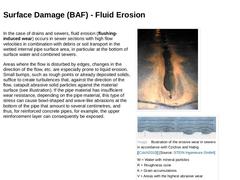
|
In the case of drains and sewers, fluid erosion (flushing-induced wear) occurs in sewer sections with high flow velocities in combination with debris or soil transport in the wetted internal pipe surface area, in particular at the bottom of surface water and combined sewers. Areas where the flow is disturbed by edges, changes in the direction of the flow, etc. are especially prone to liquid erosion. Small bumps, such as rough points or already deposited … |

|
In the given case of application, the following factors influence the flushing-induced wear: -
Pipe material
-
The geometrical design of the discharge cross-section
-
Stress condition or strain of the pipe material
-
The density of the water-solids-mixture
-
Composition of the water-solids-mixture
-
Type, size, form, viscosity, and distribution of the solid particles
-
The contact angle between solid particles and pipe wall
-
Flow velocity
-
Type of flow (…
|

|
For a long time, a possibility to reduce the wear stress in drains and sewers was seen in the limitation of the flow velocity. In 1965, for example, permissible maximum flow velocities were specified as follows [Busch65]: -
Wastewater sewers of the separate system
vmax = 2.5 m/s to 3 m/s
-
Combined and surface water sewers (due to the relatively rare peak load)
vmax = 3 m/s to 4 m/s (concrete pipes)
vmax = 4 m/s to 5 m/s (spun concrete and vitrified …
|
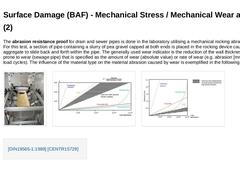
|
The abrasion resistance proof for drain and sewer pipes is done in the laboratory utilising a mechanical rocking abrasion device. For this test, a section of pipe containing a slurry of pea gravel capped at both ends is placed in the rocking device causing the aggregate to slide back and forth within the pipe. The generally used wear indicator is the reduction of the wall thickness of the body prone to wear (sewage pipe) that is specified as the … |

|
During their service life, stresses can occur in sewers which cause droplet erosion, particularly in the inlet areas of drains and connection sewers due to the impact of inflowing sewage onto the sewer wall on the opposite side of the connection and in drop structures. To some extent, the droplet erosion is a “reversion” of the cavitation erosion which is described in the following [Czich2010]. |

|
How does cavitation erosion occur? When water flows at a higher velocity in parallel to a boundary surface, each geometrical change of that area will create a change of the flow and thus, also create locally limited negative pressure areas. If, in the process, the static negative pressure of the flowing water falls below the vapour pressure, water vapour-filled bubbles are formed. Given that these bubbles enter areas where the static pressure exceeds … |
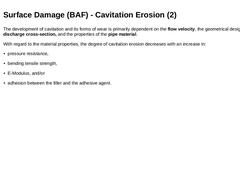
|
The development of cavitation and its forms of wear is primarily dependent on the flow velocity, the geometrical design of the discharge cross-section, and the properties of the pipe material. With regard to the material properties, the degree of cavitation erosion decreases with an increase in: |

|
The degree of cavitation erosion increases, among other things, at: Areas that are primarily prone to cavitation erosion damage in sewer systems are: |

|
|
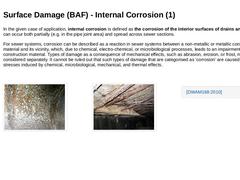
|
In the given case of application, internal corrosion is defined as the corrosion of the interior surfaces of drains and sewers. It can occur both partially (e.g. in the pipe joint area) and spread across sewer sections. For sewer systems, corrosion can be described as a reaction in sewer systems between a non-metallic or metallic construction material and its vicinity, which, due to chemical, electro-chemical, or microbiological processes, leads to … |
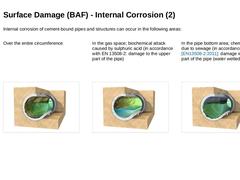
|
Internal corrosion of cement-bound pipes and structures can occur in the following areas: Over the entire circumference In the gas space; biochemical attack caused by sulphuric acid (in accordance with EN 13508-2: damage to the upper part of the pipe) In the pipe bottom area; chemical attack due to sewage (in accordance with [EN13508-2:2011]: damage in the lower part of the pipe (water wetted space) (Image: Surface Damage (BAF): Chemical attack (corrosion) - … |
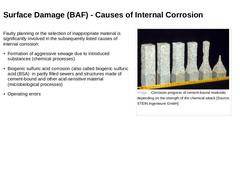
|
Faulty planning or the selection of inappropriate material is significantly involved in the subsequently listed causes of internal corrosion: -
Formation of aggressive sewage due to introduced substances (chemical processes)
-
Biogenic sulfuric acid corrosion (also called biogenic sulfuric acid (BSA) in partly filled sewers and structures made of cement-bound and other acid-sensitive material (microbiological processes)
-
Operating errors
|

|
(Image: Boundary conditions promoting internal corrosion: Incrustations, root ingrowth, insufficient flow velocity ) (Image: Boundary conditions promoting internal corrosion: Misdirection of organic waste) Internal corrosion that occurs due to chemical processes is caused by aggressive substances that are either already present in the sewage or that are formed in it in the course of its discharge. The adherence to these standards or limiting values … |
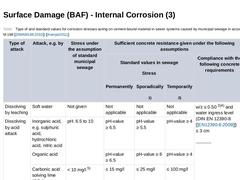
|
(Table: Type of and standard values for corrosion stresses acting on cement-bound material in sewer systems caused by municipal sewage in accordance with DWA-M 168) (Table: Limiting values for the exposure classes XA under chemical attacks due to groundwater or bodies of water of a predominantly natural composition in accordance with DIN 4030 and Schießl et al.) |

|
Simply put, the substances that cause chemical attacks to concrete or other cement-bound material can be categorised into two groups [Wieri82] [Lohse2005]: -
Substances that dissolve the cement stone and thus, lead to a decrease in the volume of the original concrete cross section (dissolving attack)
-
Substances that act like raising agents, i.e. that cause an increase of the volume while simultaneously loosening the structure (expansion attack).
|
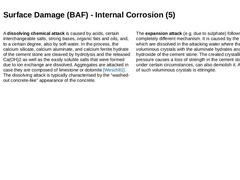
|
A dissolving chemical attack is caused by acids, certain interchangeable salts, strong bases, organic fats and oils, and, to a certain degree, also by soft water. In the process, the calcium silicate, calcium aluminate, and calcium ferrite hydrate of the cement stone are cleaved by hydrolysis and the released Ca(OH)2 as well as the easily soluble salts that were formed due to ion exchange are dissolved. Aggregates are attacked in case they are composed … |
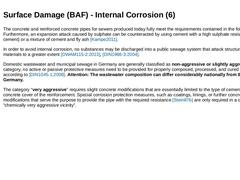
|
The concrete and reinforced concrete pipes for sewers produced today fully meet the requirements contained in the following table. Furthermore, an expansion attack caused by sulphate can be counteracted by using cement with a high sulphate resistance (HS cement) or a mixture of cement and fly ash [Kampe2011]. In order to avoid internal corrosion, no substances may be discharged into a public sewage system that attack structural and other materials … |
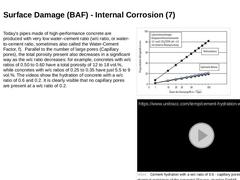
|
Today's pipes made of high-performance concrete are produced with very low water–cement ratio (w/c ratio, or water-to-cement ratio, sometimes also called the Water-Cement Factor, f). Parallel to the number of large pores (Capillary pores), the total porosity present also decreases in a significant way as the w/c ratio decreases: for example, concretes with w/c ratios of 0.50 to 0.60 have a total porosity of 12 to 18 vol.%, while concretes with w/… |
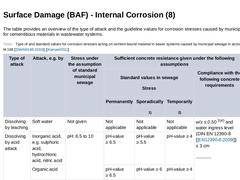
|
The table provides an overview of the type of attack and the guideline values for corrosion stresses caused by municipal wastewater for cementitious materials in wastewater systems. (Table: Type of and standard values for corrosion stresses acting on cement-bound material in sewer systems caused by municipal sewage in accordance with DWA-M 168) |

|
The category “very aggressive” requires slight concrete modifications that are essentially limited to the type of cement and the concrete cover of the reinforcement. Special corrosion protection measures, such as coatings, linings, or further concrete modifications that serve the purpose to provide the pipe with the required resistance [Stein87b] are only required in a constantly “chemically very aggressive vicinity”. Industrial wastewater that contains … |

|
|

|
A special type of internal corrosion due to microbiological processes is biogenic sulphuric acid corrosion (BSC) in partially filled sewers made of cement-bound materials (also called sulphide corrosion or biogenic acid corrosion). Whereas corrosion due to direct effects of aggressive wastewater exclusively affects the lower part of the pipe (water-wetted space), the effects of biogenic sulphuric acid corrosion (i.e. microbiological processes) are … |

|
(Image: Principle of the biogenic sulphuric acid corrosion in accordance with Bock) The proteins contained in the wastewater as well as in the sediments (the reductive part of the pipeline) are degraded by microbial processes under anaerobic or aerobic conditions to volatile sulphur compounds (mainly hydrogen sulphide). In addition, bacterial metabolism under anaerobic conditions can reduce sulphates to hydrogen sulphide (desulphurisation). The main … |
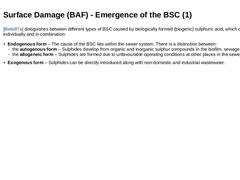
|
[Biele87a] distiguishes between different types of BSC caused by biologically formed (biogenic) sulphuric acid, which can occur both individually and in combination: -
Endogenous form – The cause of the BSC lies within the sewer system. There is a distinction between:
-
the autogenous form – Sulphides develop from organic and inorganic sulphur compounds in the biofilm, sewage, and deposits.
-
the allogeneic form – Sulphides are formed due to unfavourable …
|